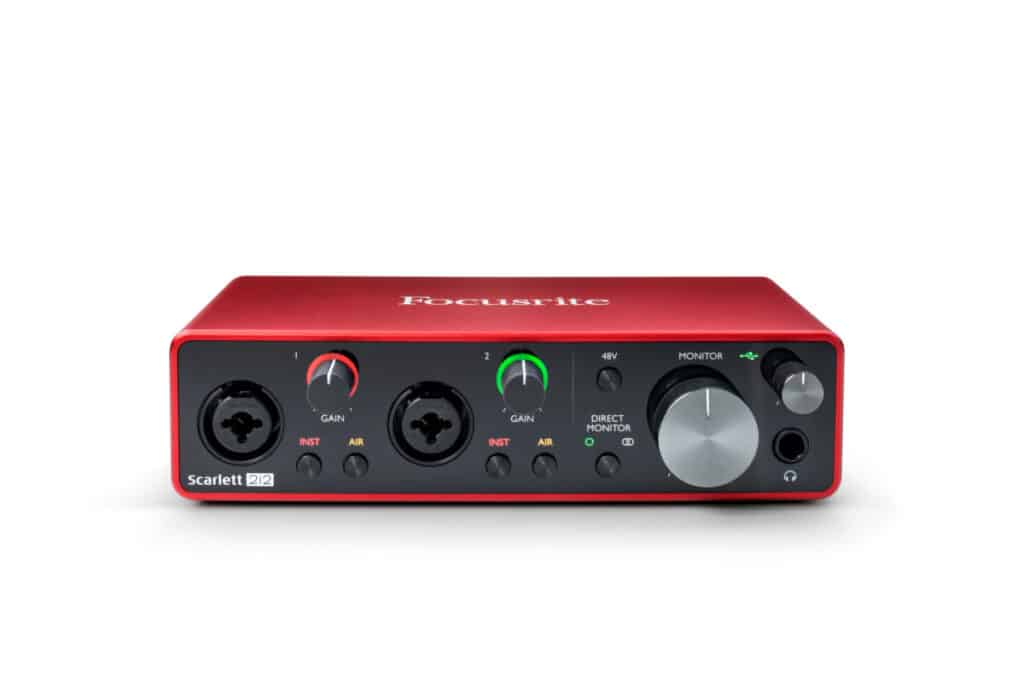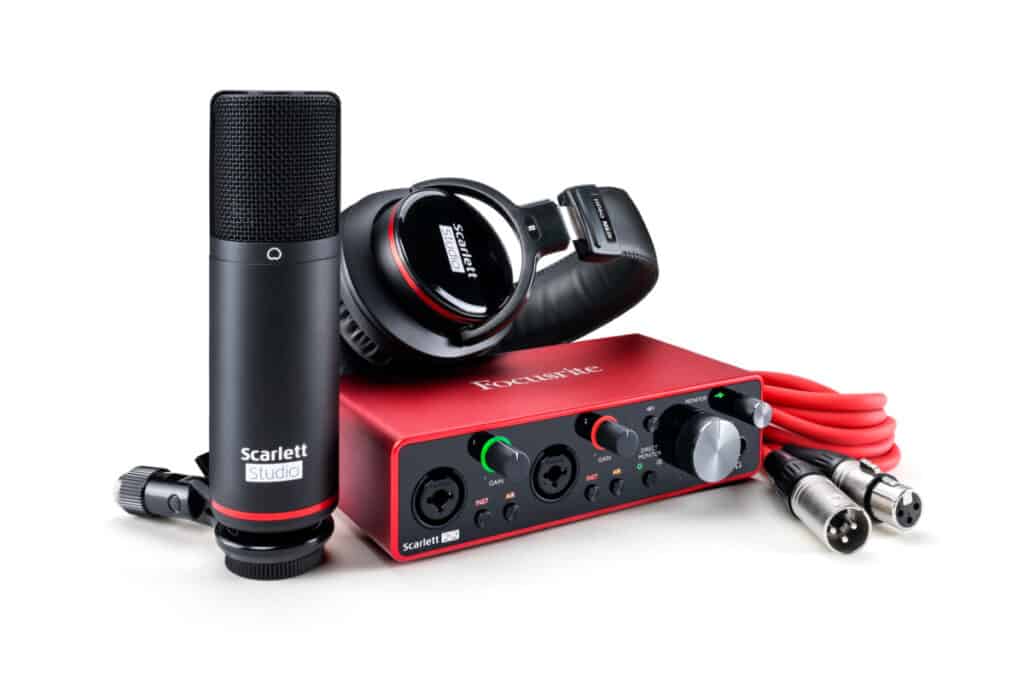Audio interfaces are great for sound recording, but they aren’t cheap. They range in price from $100 to $3000+, which is a pretty significant investment. To avoid paying these steep prices, give one of the alternative audio recording methods a try!
Yes, you can record without an audio interface. Instead, try recording with an adaptor plugged directly into your computer, a USB microphone, virtual instruments, or a tape recorder. While these methods don’t require an audio interface, they typically result in lower sound quality.
Next, we’ll go over what audio interfaces are, how they work, and whether or not you need one to record. Then, we’ll discuss several recording methods you can try that don’t require an audio interface. Lastly, we’ll explain the advantages of buying audio interfaces and why they may be worth the investment.

What Is an Audio Interface?
An audio interface is a type of external device that allows you to convert audio from your voice and instruments into digitized sounds that your computer can interpret. This permits you to store, mix, and edit high-quality sounds directly from your computer. Pretty cool, right?
How Does an Audio Interface Work?
Audio interfaces use A/D converters to translate your vocals, instruments, and other sounds into digitized computer language (1’s and 0’s), which your computer can understand and manipulate. Once the sound is converted, the audio interface can playback the audio on your computer using a D/A converter
, permitting you to hear your recorded sounds.
Generally, audio interfaces have outputs that allow you to plug in your headphones or speakers so that you can listen to your sounds in real-time and play back the recorded audio once it’s been converted.
Are Audio Interfaces Necessary for Recording?
No! There are several ways you can record your voice, instruments, and other sounds without using an audio interface. We’ll go over each of these methods below.
Record Using a Computer and Adapter
Suppose you want to record directly to a digital audio workstation (DAW), such as Garage Band or Audacity. In that case, you can plug an adapter cable into your instruments and connect it to your computer. Depending on your equipment, you’ll likely need somewhere between a ¼ inch (0.64 cm) to ⅛ inch (0.32 cm) plug.
While this recording technique is incredibly straightforward, it doesn’t result in the highest quality sound. When you record with an adapter, you rely on your computer’s sound card to produce your audio. Most computers aren’t designed with audio production in mind, resulting in low-quality sounds.
To fix this, you could custom build your laptop with better recording hardware or upgrade your current computer to have a better sound card. However, both of these solutions tend to be quite expensive. So, if you want professional quality sounds without spending a fortune, this may not be the best recording method.
Acquire a USB Microphone
USB microphones are pretty cool because they have an audio interface built into them, meaning you won’t have to purchase an external audio interface to record. You can use them to record any live sound, including vocals, instruments, or any other noises you desire. To use these mics, all you have to do is plug them into your laptop, and you are good to go!
While these microphones are easy to use and may be ideal for causal recording activities such as podcasting, the sounds they produce aren’t up to par with external audio interfaces. USB mikes have to jam-pack an audio interface and preamp into their tiny frames, resulting in less effective equipment and lower quality audio.
Because of this, many professionals avoid recording with these kinds of mics, opting for external audio interfaces instead.

Play Around With Virtual Instruments
If you are interested in making music but don’t have the equipment or budget for live recordings, why not try virtual instruments? While making songs this way may sound implausible, many music industry professionals, especially those in the EDM and other dance music genres, regularly create music using this method.
To try this technique out for yourself, you can invest in DAW software like PreSonus Studio One or Ableton Live
that has pre-recorded instrument sounds on it. However, these tend to be just as expensive as buying an audio interface, depending on the program you select. So, if you’re on a tight budget, you can use free DAWs like Garage Band to create your tunes.
Once you’ve selected your DAW software, you should purchase a MIDI keyboard, which permits you to “play” the virtual instruments, so you can create the sound you’re after. While these keyboards aren’t necessary, they make sequencing and adjusting your sounds much more manageable than when you do it directly from your computer.
This virtual recording method will allow you to make music without an audio interface. However, if you want to record your own live sounds, this technique is a no-go.
Record Analog Audio With a Tape Recorder
If you enjoy old-school recording methods, this analog recording technique is definitely something you should look into. Analog audio recording is when you use a microphone to convert sounds into electrical analog signals. These signals are directly imprinted onto reels, cassette tapes, or vinyl records. This process permits you to record your instruments and vocals directly. No audio interface required!
To record via analog, the first thing you’ll need to do is invest in a tape recorder that’ll permit you to put your sounds on tape. Be warned, this equipment isn’t easy to find and can be pretty expensive to maintain. Additionally, if you ever need replacement parts, they can be hard to come by as well.
Once you’ve acquired your recording device, you’ll need to record your sounds. Analog recordings are incredibly raw and beautiful since you’ll hear yourself precisely as you are. You won’t be able to edit or tune your voice like you can with digitized audio!
If you’d like to see this process for yourself, check out this video by YouTube singer, Mandelbro. In the video, he uses a Tascam 424 Portastudio tape recorder to record a song. He briefly discusses the history of the device and he goes through his recording process. Lastly, he shows his finished product:
Will the Audio Sound As Good if I Record Without an Audio Interface?
While the previously mentioned recording methods may be excellent options if you’re on a budget, you’re an amateur musician, or simply want to try a different recording method, none of these techniques are quite as good as recording with audio interfaces. Next, we’ll go over the main advantages of audio interfaces and why they may be worth your investment:
Audio Interfaces Produce Higher Sound Quality
As we mentioned before, the sound card on your computer isn’t designed for audio recording, so the sounds it produces are sub-par. On the other hand, audio interfaces were explicitly created for recording, making them far superior to your computer’s chip.
Additionally, many audio interfaces include pre-amps that can enhance your vocals’ quality and improve your tone, giving your audio an upgrade.
Audio Interfaces Decrease Latency
If you’ve ever recorded directly on your computer, you’ve likely experienced a problem with latency. Latency is when there is a lag between the sounds you make and when your laptop picks them up. Although your computer may only lag by a second or two, this can still be detrimental when you’re recording because it makes it hard for you to play or sing in time.
With audio interfaces, latency will be less of an issue since they are faster than your computer’s sound chip, allowing you to hear your sounds within milliseconds of when they are actually played.
Conclusion
There are several methods you can use to record without an audio interface. These include:
- Recording with a computer and an adapter
- Producing songs with a USB microphone
- Making music with virtual instruments
- Using a tape recorder to make analog audio
While these techniques are fantastic for amateur musicians, you should invest in an audio interface to produce a more professional sound.
Sources
- Hollywood DJ: What does an audio interface do?
- Musician’s HQ: Do You Need an Audio Interface to Record Vocals, Guitar, Bass, or Anything Else?
- YouTube: Producing a Song Entirely on a 424 Tape Recorder
- Sound on Sound: Living With Latency
- Brian Li: How an Audio Interface Reduces Latency for Music Production
Recent Posts
QuickTime is a vital app for many Mac users, and if you’ve recently bought a new microphone, you might wonder how to use it optimally. QuickTime cannot record audio content if it doesn’t have...
Every microphone leaves a unique signature on the quality of its output. If you’re a podcaster trying to melt your way into your audience’s hearts, a muddy, distorted recording won’t cut it....
